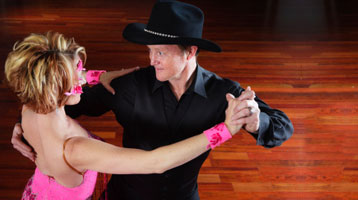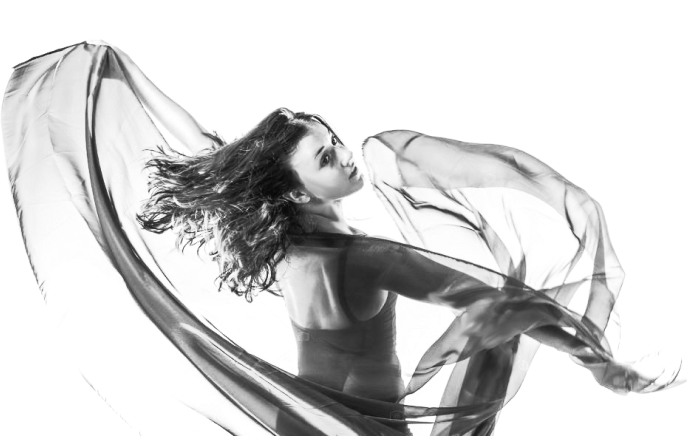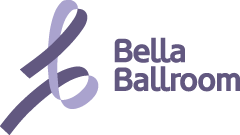
Social Dance
Country Two Step
Also known as the Texas Two Step or Country Western Two Step, this popular social dance is a lot of fun. Danced with a partner, this dance is characterized by turns and improvisations and is typically danced to country music.
History of the Country Two Step
While it is unknown exactly when the country two-step was first created, it is agreed that the dance’s evolution was born out of a combination of already existing social dances. Country Two Step emerged out of the Foxtrot and the One Step. In the early 1800’s what was called a “two step” was known as a two beat waltz called the “valse a deux temps”. It’s believed that this two beat Waltz is the origin of the movement similar to a chasse in the modern day Country Two Step. By 1847, writer Henri Cellarius voiced that the “valse a deux temps” would be better called “deux pas” or as it is known today, “two step”.
In 1891, John Phillip Sousa who was well known for his musical creations composed the “Washington Post March”. The Two Step was danced to this music and became more popular. Dancers used the one step and the two step move to the music of the time more and more. The two step of the 1890s looked quite different than the dance of the two step today
Country Two Step developed in the United States into what it is today with the fusion of the earlier known two step with the collegiate foxtrot. The collegiate foxtrot was a more carefree version of the traditional foxtrot and was popular in 1910 and again in the 1940s among the children’s square dancing community. As the young generation of square dancers grew older, this dance became a regular part of adult country dancing repertoire. As the two step entered into the Square dancing community it became associated with country music, it became known as the “Country Foxtrot” or “Texas Two.” Over the years, it developed into it’s own distinct style of Country dancing wherein Country-Two-Step and Texas Two Step dancers move counter-clockwise around the floor using a series of “Slow” and “Quick” steps.
In the 1970s movies like “Urban Cowboy” (which featured movie dance icon and actor John Travolta) popularized the two step even further. While the ballroom dancers that choreographed for the Hollywood films often integrated a few Foxtrot movements into the performances, they did not integrate the rise and fall of the Foxtrot. This gave the Two Step a distinct character. The flat-footed execution of the Two Step’s figures became even more pronounced with time making it quite distinct from its smooth foxtrot counterpart.
When the Two Step grew popular in Texas, dancers initially didn’t do the rotational patterns in the line of dance around the dance floor as they do today. They often danced from one end of the dance floor to the other simply by performing a series of turns. During this time dancers would often do the jitterbug, a non traveling dance, when they reached the end of the floor because they had run out of space. Eventually the Texas Two Step dance evolved beyond being danced only in a straight line into the dance it is today.
Country Two Step Today
Today the Two Step is a popular social dance known as a traveling dance that combines turns and complex patterns and fun improvisations around the dance floor. It has become very popular even though it’s was only developed in the 19th century and not as old as the other partner dances.
Two Step is danced in country themed bars and dance halls across the United States. Dancers also popularly practice and learn the Two Step in dance studios and ballrooms throughout the nation. Two Step dancing is often accompanied by country line dancing and country swing at dance events and country dance bars.
While Country Two Step is not a dance category of the official national international ballroom competitions, Two Step dance competitions are held by private organizations, businesses and dance tours. In a “Jack-and-Jill” contest, female and male participants within the same age and skill level division are randomly paired. The couples compete by dancing against each other even though the leader and follower of each pair may not even know each other. The results of assigned judges determine who the top performers are and the top dancers are awarded cash or other prizes.
Country Two Step has gained national exposure on TV shows like “Dancing with the Stars” where two dancers performed a choreographed two step for critiquing judges.
Today, the Two Step is popularly danced to country classics and modern country pop. Partners will generally start in a closed position with the pair facing each other and the leader facing in the line of dance. Other popular country dance positions include the sweetheart, the shadow, the wrap, the skater, promenade and reverse promenade. While the dance is most commonly danced in steps of a quick, quick, slow, slow pattern, more complex and advanced figures can be syncopated and danced in other patterns such as quick, quick, slow, quick, quick, slow (QQSQQS) or quick, quick, quick, quick, slow, slow (QQQQSS).
Country Two Step Songs
- “Sold” John Michael Montgomery
- “Trouble” Travis Tritt
- “Let’s Go To Vegas” Faith Hill
- “Just to See You Smile” Tim McGraw
- “Little Bitty” Alan Jackson
- “Chattahoochie” – Alan Jackson
- “Fireman” George Straight
- “Redneck Woman” Gretchen Wilson
- “American Saturday” Night Brad Paisley
- “She’s Country” Jason Aldean
- “She Wouldn’t Be Gone” Blake Shelton
- “Little Bit of Life” Craig Morgan
- “Everyday America” Sugarland
- “Firecracker” Josh Turner
- “A Different World” Bucky Covington
- “Just to See You Smile” Tim McGraw
- “Toes” Zac Brown Band
- “Creepin’” Eric Church
- “Do You Want Fries With That” Tim McGraw
- “Long Black Train” Josh Turner
- “You Belong to Me” Taylor Swift
- “Dance With the One that Brought You” Shania Twain
- “Small Town Southern Man” Alan Jackson
- “Any Man of Mine” Shania Twain
- “Good Ride Cowboy” Tim McGraw
- “Feels Like Love” Vince Gill
- “Back When” Tim McGraw
- “Why Why Why” Billy Currington
- “Beer in Mexico” Kenny Chesney
- “Fore She Was Mama” Clay Walker
- “Watching You” Rodney Atkins
- “Come On Over Tonight” Brad Paisley
- “Welcome to the Future” Brad Paisley
- “Redneck Women” Gretchen Wilson
- “Country Boy” Alan Jackson
- “Chasin’ That Neon Rainbow” Alan Jackson
- “Out Last Night” Kenny Chesney
- “I Don’t Work That Hard” Blaine Jackson
- “Love Don’t Live Here” Lady Antebellum
- “I Finally Found Somebody” Kenny Chesney


